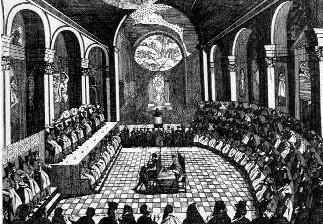Date 1139 | Accepted by Roman Catholicism | |
 | ||
Next council | ||
The Second Council of the Lateran is believed to have been the Tenth Ecumenical Council by Roman Catholics. It was held by Pope Innocent II in April 1139, and was attended by close to a thousand clerics. Its immediate task was to neutralise the after-effects of the schism which had arisen after the death of Pope Honorius II in 1130 and the papal election in the same year that set up Petris Leonis as the antipope Anacletus II.
Contents
Tenth ecumenical council
After the death of Honorius II, Petrus Leonis, under the name of Anacletus II, was elected as Pope by a majority of the cardinals and with the support of the people of Rome on the same day as a minority elected Innocent II. In 1135, Innocent II held a council at Pisa, which confirmed his authority and condemned Anacletus. Anacletus's death in 1138 helped largely to solve the tension between rival factions. Nevertheless, Innocent decided to call the tenth ecumenical council.
The Council assembled at the Lateran Palace and nearly a thousand prelates attended. In his opening statement Innocent deposed those who had been ordained and instituted by Anacletus or any of his adherents. King Roger II of Sicily was excommunicated for maintaining what was thought to be a schismatic attitude.
The council also condemned the teachings of the Petrobrusians and the Henricians, the followers of Peter of Bruys and Henry of Lausanne. Finally, the council drew up measures for the amendment of ecclesiastical morals and discipline which the council fathers considered had grown lax. Many of the canons relating to these matters were mostly a restating of the decrees of the Council of Reims and the Council of Clermont.
Important canons
The most important results of the council included:
Another decision confirmed the right of religious houses of a diocese to participate in the election of the diocese's bishop.
